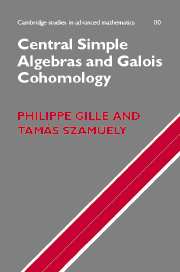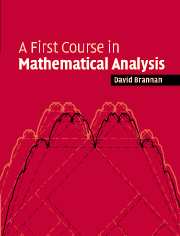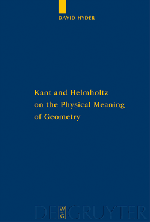Philippe Gille / Centre National de la Recherche Scientifique (CNRS), Paris
Tamas Szamuely / Alfred Renyi Institute of Mathematics, Hungarian Academy of Sciences, Budapest
Central Simple Algebras and Galois Cohomology
 Series: Cambridge Studies in Advanced Mathematics (No. 101)
Series: Cambridge Studies in Advanced Mathematics (No. 101)
Hardback (ISBN-10: 0521861039 | ISBN-13: 9780521861038)
July 2006
This book is the first comprehensive, modern introduction to the
theory of central simple algebras over arbitrary fields. Starting
from the basics, it reaches such advanced results as the
Merkurjev-Suslin theorem. This theorem is both the culmination of
work initiated by Brauer, Noether, Hasse and Albert and the
starting point of current research in motivic cohomology theory
by Voevodsky, Suslin, Rost and others. Assuming only a solid
background in algebra, but no homological algebra, the book
covers the basic theory of central simple algebras, methods of
Galois descent and Galois cohomology, Severi-Brauer varieties,
residue maps and, finally, Milnor K-theory and K-cohomology. The
last chapter rounds off the theory by presenting the results in
positive characteristic, including the theorem of Bloch-Gabber-Kato.
It is suitable as a textbook for graduate students and as a
reference for researchers working in algebra, algebraic geometry
or K-theory.
* Modern, comprehensive introduction assuming only a solid
background in algebra, but no homological algebra; necessary
results from algebraic geometry are summarized in an appendix
* Accessible proof of the Merkurjev-Suslin theorem
* First textbook treatment of characteristic p methods, including
the Jacobson-Cartier and Bloch-Gabber-Kato theorems
Contents
1. Quaternion algebras; 2. Central simple algebras and Galois
descent; 3. Techniques from group cohomology; 4. The
cohomological Brauer group; 5. Severi-Brauer varieties; 6.
Residue maps; 7. Milnor K-theory; 8. The Merkurjev-Suslin
theorem; 9. Symbols in positive characteristic; Appendix: A
breviary of algebraic geometry; References; Index.
David Brannan
The Open University, Milton Keynes
A First Course in Mathematical Analysis
 Paperback (ISBN-10: 0521684242 | ISBN-13: 9780521684248)
Paperback (ISBN-10: 0521684242 | ISBN-13: 9780521684248)
Hardback (ISBN-10: 0521864399 | ISBN-13: 9780521864398)
August 2006
Mathematical Analysis (often called Advanced Calculus) is
generally found by students to be one of their hardest courses in
Mathematics. This text uses the so-called sequential approach to
continuity, differentiability and integration to make it easier
to understand the subject.
Topics that are generally glossed over in the standard Calculus
courses are given careful study here. For example, what exactly
is a 'continuousf function? And how exactly can one give a
careful definition of eintegralf? The latter question is
often one of the mysterious points in a Calculus course - and it
is quite difficult to give a rigorous treatment of integration!
The text has a large number of diagrams and helpful margin notes;
and uses many graded examples and exercises, often with complete
solutions, to guide students through the tricky points. It is
suitable for self-study or use in parallel with a standard
University course on the subject.
* A sequential approach to continuity, differentiability and
integration to make it easier to understand the subject
* Many graded examples and exercises, with large numbers of
complete solutions, to guide students through the tricky points
* Suitable for self-study or use in parallel with a standard
University course; unlike other textbooks in the subject, should
be intelligible to students on their own, offering considerable
study help
Contents
Preface; 0. Introduction: Calculus and Analysis; 1. Numbers; 2.
Sequences; 3. Series; 4. Continuity; 5. Limits and continuity; 6.
Differentiation; 7. Integration; 8. Power series; Appendix 1.
Sets, functions and proofs; Appendix 2. Standard derivatives and
primitives; Appendix 3. The first 1,000 decimal places of the
square root of 2, e and p; Appendix 4. Solutions to the problems;
Index.
Jana Jureckova / Charles University, Prague, Czech Republic
Jan Picek / Technical Univ. of Liberec, Liberec, Czech Republic
Robust Statistical Methods with R
ISBN: 1584884541
Publication Date: 12/7/2005
Number of Pages: 216
Provides a systematic, practical treatment of robust statistical
methods
Offers a rigorous treatment of the whole range of robust methods,
including distance of measures, influence functions, and
asymptotic distributions
Emphasizes the computational aspects, supplying many examples and
exercises along with algorithms using R software
Serves as a text for graduate and post-graduate study as well as
a useful reference for statisticians and quantitative scientists
Robust statistical methods were developed to supplement the
classical procedures when the data violate classical assumptions.
They are ideally suited to applied research across a broad
spectrum of study, yet most books on the subject are narrowly
focused, overly theoretical, or simply outdated. Robust
Statistical Methods with R provides a systematic treatment of
robust procedures with an emphasis on practical application.
The authors work from underlying mathematical tools to
implementation, paying special attention to the computational
aspects. They cover the whole range of robust methods, including
differentiable statistical functions, distance of measures,
influence functions, and asymptotic distributions, in a rigorous
yet approachable manner. Highlighting hands-on problem solving,
many examples and computational algorithms using the R software
supplement the discussion. The book examines the characteristics
of robustness, estimators of real parameter, large sample
properties, and goodness-of-fit tests. It also includes a brief
overview of R in an appendix for those with little experience
using the software.
Based on more than a decade of teaching and research experience,
Robust Statistical Methods with R offers a thorough, detailed
overview of robust procedures. It is an ideal introduction for
those new to the field and a convenient reference for those who
apply robust methods in their daily work.
Table of contents
Frank Beichelt / University of Witwatersrand, South Africa
Stochastic Processes in Science, Engineering and Finance
ISBN: 1584884932
Publication Date: 2/10/2006
Number of Pages: 408
Emphasizes applications in various fields of science,
engineering, and finance
Features numerous examples to represent the subject in an
accessible way
Includes a self-contained review of probability-theoretic topics
Provides proofs, examples, and exercises
Offers a solutions manual
Stochastic Processes in Science, Engineering, and Finance
emphasizes applications in various fields. This book features
numerous worked examples to represent the subject in a
comprehensible, user-friendly way. It includes a self-contained
review of probability-theoretic topics and provides a large
number of exercises with solutions as well as important proofs
and theoretically challenging examples for the mathematically
interested reader. The text makes an ideal reference for senior
undergraduate and graduate students in stochastic processes,
practitioners, and researchers in mathematical finance,
operations, industrial engineering, electrical engineering, and
actuarial science.
Table of Contents
Probability Theory. Basics of Stochastic Processes. Random Point
Processes. Markov Chains in Discrete Time. Markov Chains in
Continuous Time. Martingales. Brownian Motion.
Hyder, David
Kant and Helmholtz on the Physical Meaning of Geometry
23 x 15.5 cm. Approx. X, 174 pages. Cloth. Approx. ISBN 3-11-018391-9
Series: Quellen und Studien zur Philosophie 69
Subjects:
 Philosophy / History of Philosophy / 18th and 19th Centuries / Kant and
his Age
Philosophy / History of Philosophy / 18th and 19th Centuries / Kant and
his Age
Philosophy / Theoretical Philosophy / Philosophy of Science,
Philosophy of Nature, Technology, Mathematics
Language: English
to be published May 2006
This book offers a new interpretation of Hermann von Helmholtzfs
work on the epistemology of geometry. A detailed analysis of the
philosophical arguments of Helmholtzfs Erhaltung der Kraft
shows that he took physical theories to be constrained by a
regulative ideal. They must render nature gcompletely
comprehensibleh, which implies that all physical magnitudes
must be relations among empirically given phenomena. This
conviction eventually forced Helmholtz to explain how geometry
itself could be so construed. Hyder shows how Helmholtz answered
this question by drawing on the theory of magnitudes developed in
his research on the colour-space. He argues against the dominant
interpretation of Helmholtzfs work by suggesting that for the
latter, it is less the inductive character of geometry that makes
it empirical, and rather the regulative requirement that the
system of natural science be empirically
 Series: Cambridge Studies in Advanced Mathematics (No. 101)
Series: Cambridge Studies in Advanced Mathematics (No. 101) Paperback (ISBN-10: 0521684242 | ISBN-13: 9780521684248)
Paperback (ISBN-10: 0521684242 | ISBN-13: 9780521684248) Philosophy / History of Philosophy / 18th and 19th Centuries / Kant and
his Age
Philosophy / History of Philosophy / 18th and 19th Centuries / Kant and
his Age